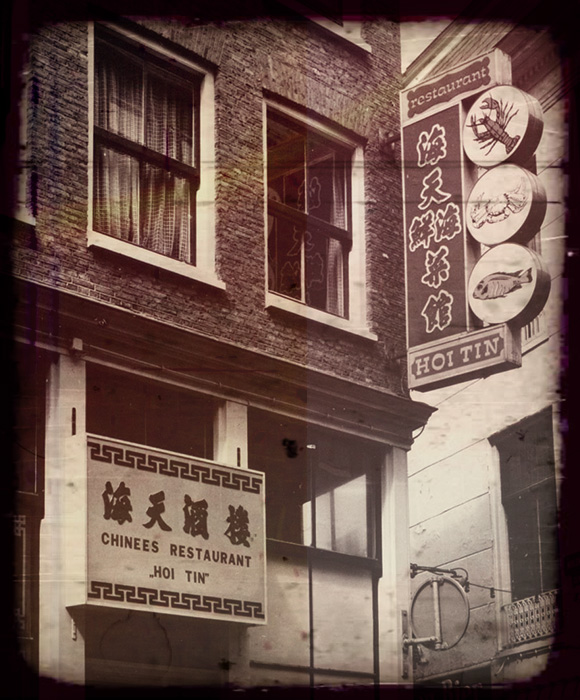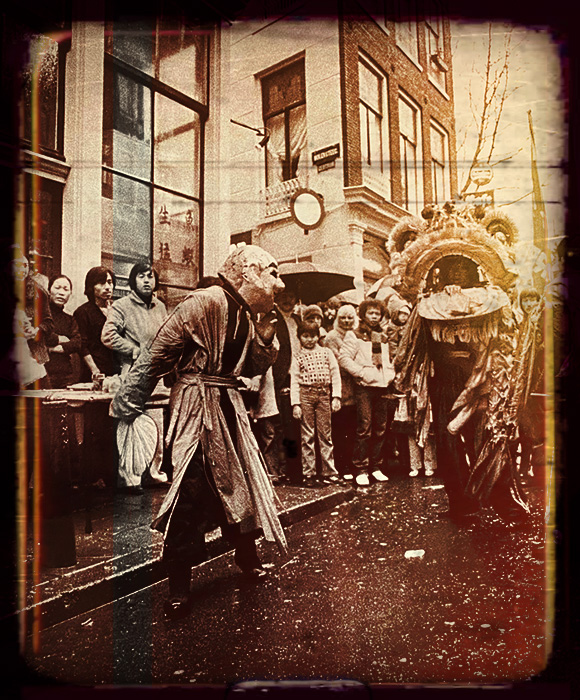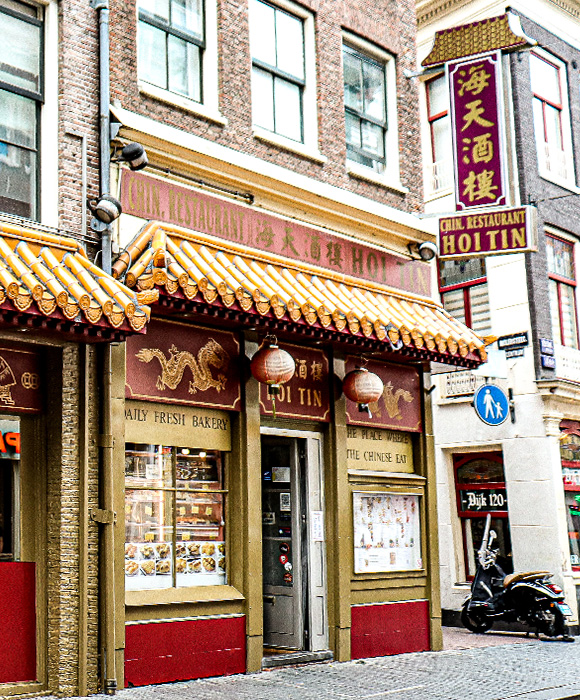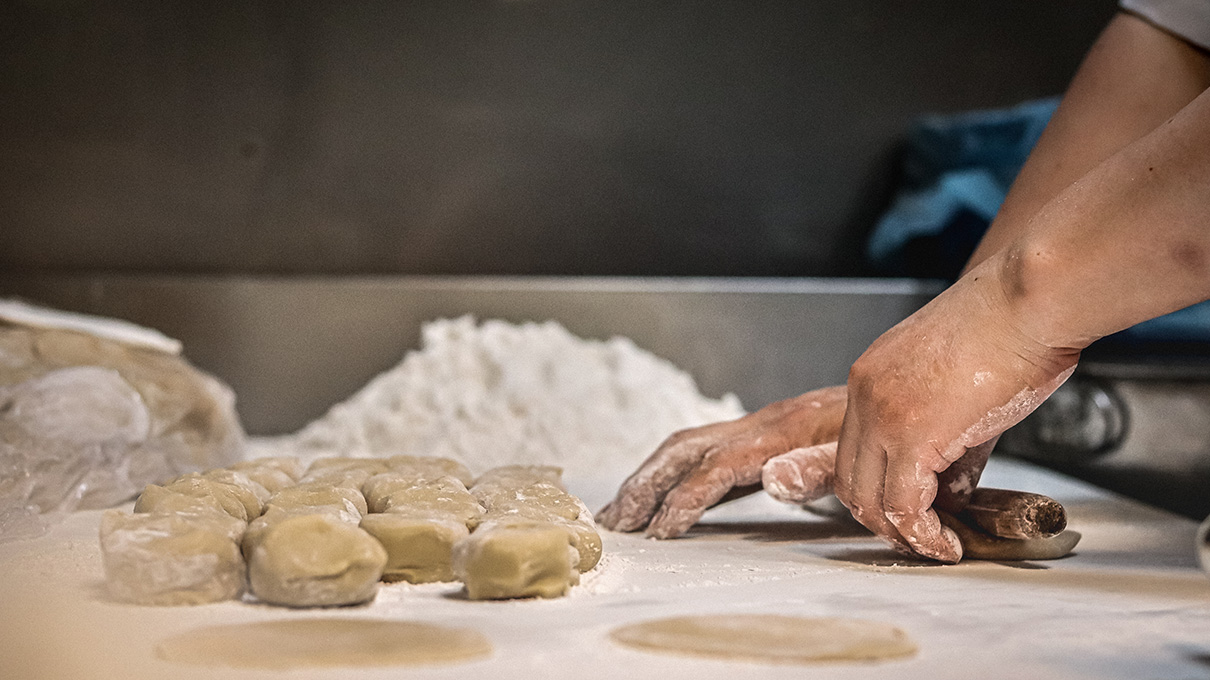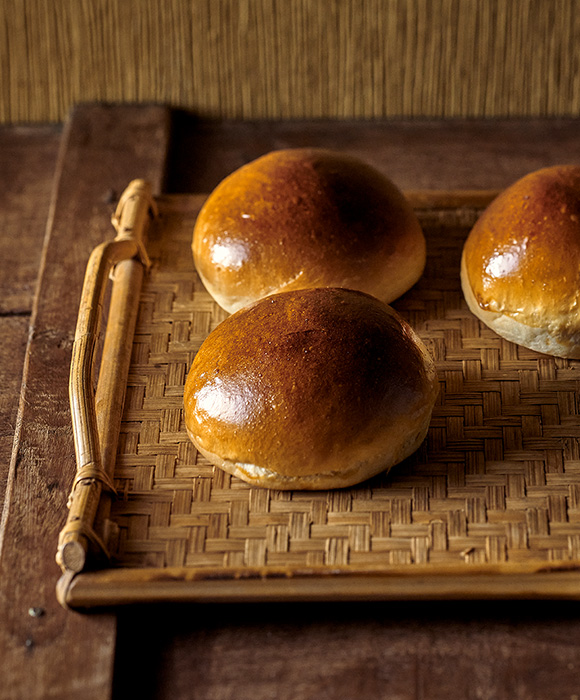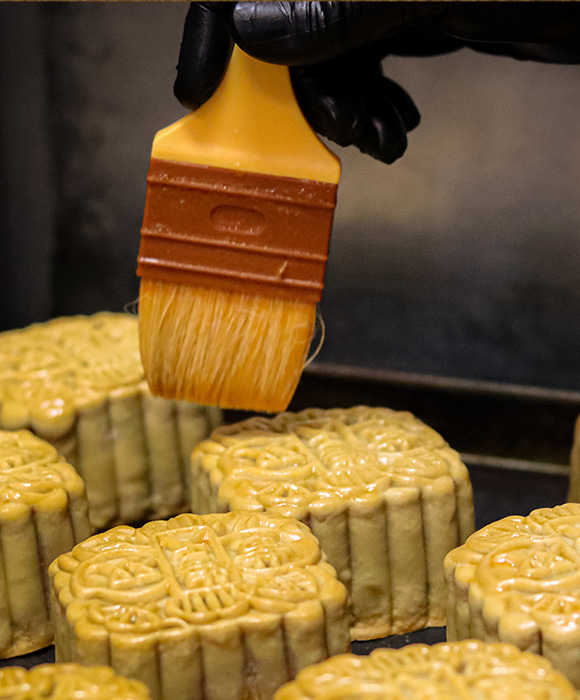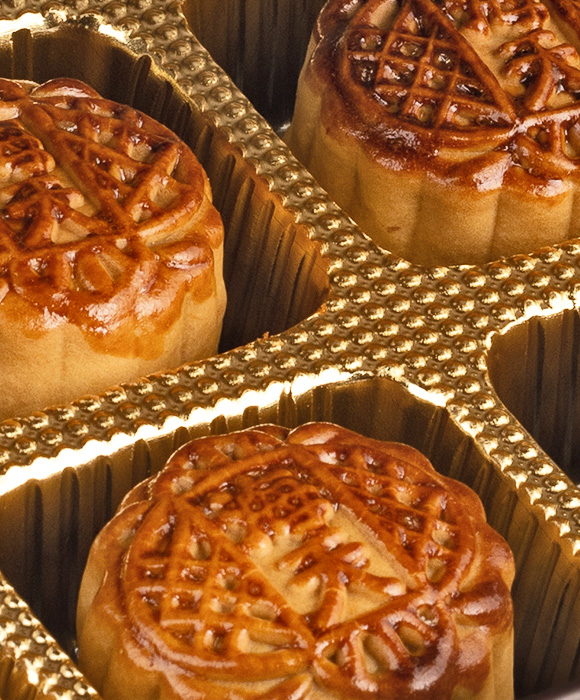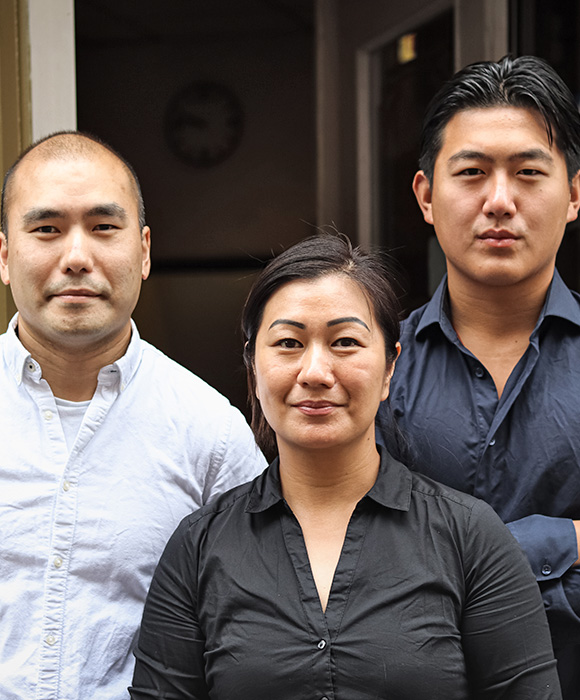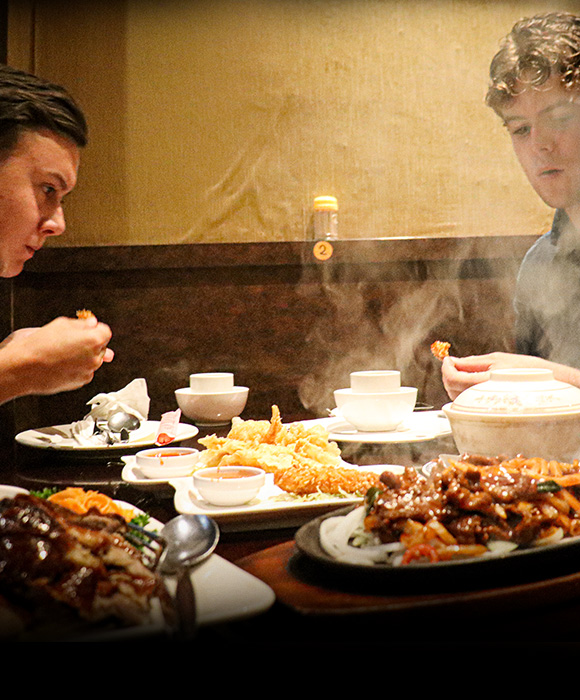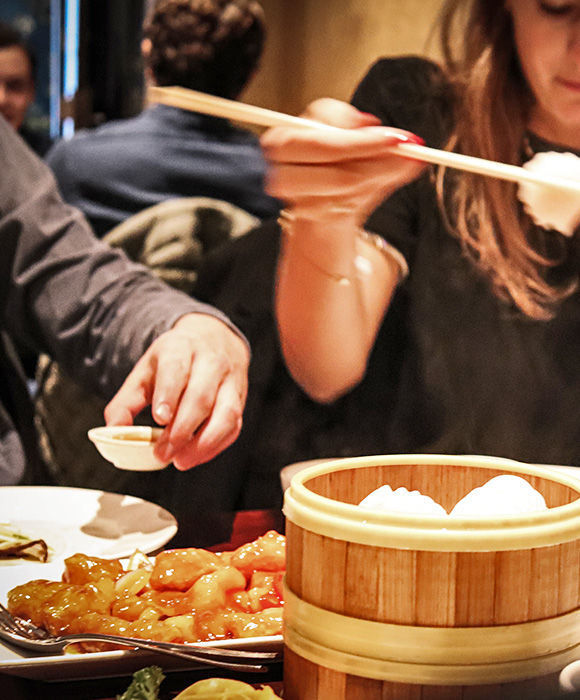Discover
The Legacy of Hoi Tin
The oldest in Europe.
Stretching from the Zeedijk to the Nieuwmarkt, Amsterdam’s Chinatown dates from just after the turn of the 20th century.What began as a few local restaurants has grown into a truly unique neighbourhood in the oldest part of Amsterdam. Fitting, as Amsterdam’s Chinatown itself is the oldest in mainland Europe. Aside from an impressive range of culinary delights, Amsterdam’s Chinatown also boasts the largest Chinese-styled Buddhist building in Europe: the Fo Guang Shan He Hua – or Lotus flower – Temple.
Enter another world.
Walk through this neighbourhood, with its Asian sights, sounds, aromas and even street names….and for a short while be transported to a completely other, exotic world. If you’re fortunate enough to find yourself here during the yearly Vesak festival, you can join a multitude of others in celebrating the birth, enlightenment and death of the Buddha.
Chinadam
Chinese culture prevails in this small but exotic part of Amsterdam, even though the area is actually quite diverse. While the Chinese district was created in 1911, it was only in the 1930’s that the general public came into regular contact with the Chinese living here, often when buying popular peanut biscuits from unemployed sailors who had been laid off during the Great Depression. Establishments initially catering to Chinese sailors gradually became known to a larger public and became popular and well-established businesses. Hoi Tin, with its Chinese tiled roof, its bustling clientele from all corners of the world, and its authentic Cantonese fare harks back to this dynamic period.
The Legacy of Hoi Tin
The oldest in Europe.
Stretching from the Zeedijk to the Nieuwmarkt, Amsterdam’s Chinatown dates from just after the turn of the 20th century.What began as a few local restaurants has grown into a truly unique neighbourhood in the oldest part of Amsterdam. Fitting, as Amsterdam’s Chinatown itself is the oldest in mainland Europe. Aside from an impressive range of culinary delights, Amsterdam’s Chinatown also boasts the largest Chinese-styled Buddhist building in Europe: the Fo Guang Shan He Hua – or Lotus flower – Temple.
Enter another world.
Walk through this neighbourhood, with its Asian sights, sounds, aromas and even street names….and for a short while be transported to a completely other, exotic world. If you’re fortunate enough to find yourself here during the yearly Vesak festival, you can join a multitude of others in celebrating the birth, enlightenment and death of the Buddha.
Chinadam
Chinese culture prevails in this small but exotic part of Amsterdam, even though the area is actually quite diverse. While the Chinese district was created in 1911, it was only in the 1930’s that the general public came into regular contact with the Chinese living here, often when buying popular peanut biscuits from unemployed sailors who had been laid off during the Great Depression. Establishments initially catering to Chinese sailors gradually became known to a larger public and became popular and well-established businesses. Hoi Tin, with its Chinese tiled roof, its bustling clientele from all corners of the world, and its authentic Cantonese fare harks back to this dynamic period.
The Bakery
Congratulations!
You’ve discovered the only restaurant with a traditional Cantonese bakery. One taste of this bakery’s exceptional selection of more than 20 different homemade buns and pastries will convince you that Hoi Tin is special. And you won’t be alone. Fresh ingredients and quality Cantonese tradition are what has kept bringing loyal, happy customers back for more than 45 years.
Moon-struck
Our signature pastry is our Moon Cake. Originated in China to honour the goddess of the moon, the moon cake is a traditional pastry that is eaten during the mid-autumn festival in the months of September and October. Widely celebrated by Asians around the world, the mid-autumn festival celebrates not only the full moon, but being together as a family. And when you enjoy a Hoi Tin moon cake, you’re celebrating being part of the Hoi Tin family.
Our moons are not made of cheese
A moon cake is a richly filled pastry with different types of pasta such as lotus seed and red beans. Our moon cakes are always made fresh, with our own traditional recipe. Making a proper moon cake includes many steps and can take up to 3 hours. We let our moon cakes rest for two days, letting the flavours, colour and texture all blend together perfectly. For an extra special twist, we also make moon cakes with yellow salted eggs.
The Bakery
From pastries to Moon Cakes.
Pure Artistry.
Congratulations!
You’ve discovered the only restaurant with a traditional Cantonese bakery. One taste of this bakery’s exceptional selection of more than 20 different homemade buns and pastries will convince you that Hoi Tin is special. And you won’t be alone. Fresh ingredients and quality Cantonese tradition are what has kept bringing loyal, happy customers back for more than 45 years.
Moon-struck
Our signature pastry is our Moon Cake. Originated in China to honour the goddess of the moon, the moon cake is a traditional pastry that is eaten during the mid-autumn festival in the months of September and October. Widely celebrated by Asians around the world, the mid-autumn festival celebrates not only the full moon, but being together as a family. And when you enjoy a Hoi Tin moon cake, you’re celebrating being part of the Hoi Tin family.
Our moons are not made of cheese
A moon cake is a richly filled pastry with different types of pasta such as lotus seed and red beans. Our moon cakes are always made fresh, with our own traditional recipe. Making a proper moon cake includes many steps and can take up to 3 hours. We let our moon cakes rest for two days, letting the flavours, colour and texture all blend together perfectly. For an extra special twist, we also make moon cakes with yellow salted eggs.
Restaurant
All in the family
Now it its 3rd generation, Hoi Tin is headed by Ethan Lo, his mother Susan and his uncle Alex. Together with their dedicated and talented staff they serve a wide range of dishes from Dim Sum to Wok dishes and roasted meats. All the while keeping their grandfather’s legacy alive. Grandfather Man did so much for the Chinese community and the elderly in the neighbourhood that he was bestowed a Knighthood of the Order of Orange-Nassau. Today, his family continues to deepen Dutch and Asian ties and understanding in the most delicious of ways.
The Far East is closer than you think!
Restaurant Hoi Tin is an authentic Cantonese restaurant, right in the heart of Amsterdam! Serving a wide range of dishes from Dim Sum to Wok dishes and roasted meats, Hoi Tin is run by Susan and her son Ethan, the 3rd generation of this landmark family restaurant. Ethan’s grandfather loved baking. So, when he decided to open a restaurant (after moving to The Netherlands from Hong Kong in 1965), it seemed natural to include a traditional Cantonese bakery. Since then, the ovens have never cooled! Hoi Tin’s baked goods not only feature prominently in their own restaurant, but in many other top Chinese restaurants as well.
VAT (Value Added Tradition)
While many things have changed over the years (for instance, the Chinese roof tiles on the outside were added later to give the building a more authentic Chinatown feel and connect it to the temple), what has never changed are Hoi Tin’s values of Authenticity, Excellence and Integrity. As a family institution with a long and respected history, Hoi Tin is always careful about the right balance between tradition and innovation, open to new ideas but never forgetting its rich heritage. Entering Hoi Tin is to be welcomed by a warmth, openness and humility that truly belongs to a simpler, more personal world.
Restaurant
All in the family
Now it its 3rd generation, Hoi Tin is headed by Ethan Lo, his mother Susan and his uncle Alex. Together with their dedicated and talented staff they serve a wide range of dishes from Dim Sum to Wok dishes and roasted meats. All the while keeping their grandfather’s legacy alive. Grandfather Man did so much for the Chinese community and the elderly in the neighbourhood that he was bestowed a Knighthood of the Order of Orange-Nassau. Today, his family continues to deepen Dutch and Asian ties and understanding in the most delicious of ways.
The Far East is closer than you think!
Restaurant Hoi Tin is an authentic Cantonese restaurant, right in the heart of Amsterdam! Serving a wide range of dishes from Dim Sum to Wok dishes and roasted meats, Hoi Tin is run by Susan and her son Ethan, the 3rd generation of this landmark family restaurant. Ethan’s grandfather loved baking. So, when he decided to open a restaurant (after moving to The Netherlands from Hong Kong in 1965), it seemed natural to include a traditional Cantonese bakery. Since then, the ovens have never cooled! Hoi Tin’s baked goods not only feature prominently in their own restaurant, but in many other top Chinese restaurants as well.
VAT (Value Added Tradition)
While many things have changed over the years (for instance, the Chinese roof tiles on the outside were added later to give the building a more authentic Chinatown feel and connect it to the temple), what has never changed are Hoi Tin’s values of Authenticity, Excellence and Integrity. As a family institution with a long and respected history, Hoi Tin is always careful about the right balance between tradition and innovation, open to new ideas but never forgetting its rich heritage. Entering Hoi Tin is to be welcomed by a warmth, openness and humility that truly belongs to a simpler, more personal world.

